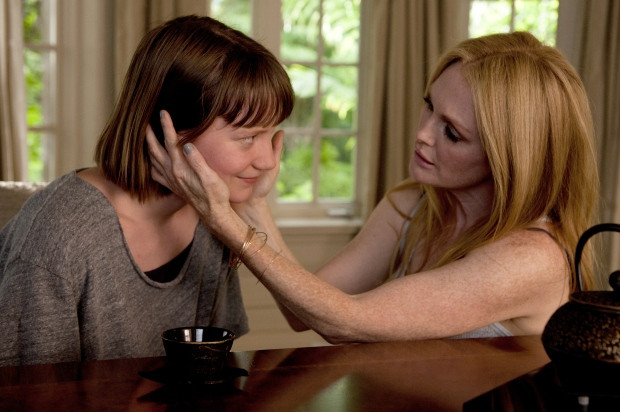It seems to be a rite of passage for every major filmmaker to cast their eye back on the industry that birthed them/spat them out. Hollywood is a venal and vain town; even in its more laid-back and hearty depictions (think of TV’s Entourage), it’s laddish and emotionally limp. As you can probably guess, this writer has never been. After David Cronenberg’s Maps To The Stars, a visit seems less likely, at least not before someone’s gone to town on the place with a damp cloth and disinfectant.
Even when dealing with something as rote as the industry within which he works, Cronenberg has to play the outsider. Indeed, Maps To The Stars is the first film he’s shot in the United States (and even then, it was only for five days of the 29-day shoot). The Canadian auteur brings his trademark style to Tinseltown; like so much of his oeuvre, Maps To The Stars is clinical, odd and a little gooey. The script must have appealed to Cronenberg; it’s filled with physically and mentally scarred oddballs obsessed with the unobtainable. It’s nothing new to the director of The Fly and Dead Ringers but, as evidenced in his verbose-but-dry adaptation of Don DeLillo’s Cosmopolis, Cronenberg’s in full-on satirical mode after the relatively straight-laced likes of Eastern Promises. Granted, he’s always got something to say, but his new plunge into the dark heart of Hollywood must be his most biting piece of commentary since Videodrome. Long live the new flesh.
It’s typical Cronenberg: the withering old flesh giving way to the new. Washed-up actress Havana Segrand (Julianne Moore) is lobbying for the lead role in a remake of the film that made her mother Clarice famous. Meanwhile, Benjie Weiss (Evan Bird) is aiming to get back to tween stardom following a stint in rehab. Between Moore channeling the breakdown of fellow redhead LiLo and Benjie nodding to Drew Barrymore, Maps To The Stars sounds like it’s taking some easy potshots. Hollywood’s a big target, but Cronenberg and writer Bruce Wagner put a darker twist on things via the arrival in Tinseltown of Agatha (Mia Wasikowska). Scarred after a fire, this awkward mite gets a job as Havana’s assistant via their mutual friend Carrie Fisher. Playing herself, Fisher is the only big name cameo in the film. The Player’s game of celebrity bingo may have given it a certain gravitas and comforting cushion, but Maps To The Stars isn’t interested in molly-coddling. The sunshiny sterility of the design and cinematography give the film a coldness that can’t be offset by endorsements or familiarity, which in turn feeds into the script’s screwed-up screw turns.
As is the way of such blow-ins, Agatha comes with secrets. Being hired by Havana brings her back into the orbit of her estranged family, led by her father (and Havana’s therapist-cum-masseur) Stafford (John Cusack). Agatha’s ultimate aim is to get back to little brother Benjie, with whom she has a quasi-incestuous infatuation. Here we arrive at the crux of Maps To The Stars’ message. It’s not enough to say Hollywood is shallow, or even soulless. It’s deviant and perverted, with everyone wearing Freudian slip-ons and choking on Xanax. Havana is haunted by the ghost of the late Clarice (Sarah Gadon) to the point her sexual encounters turn into Ghost, sponsored by relapse. Of course, when she’s pinning a comeback on playing her mother’s role, she’ll never allow herself an escape from this spectre. (At one point, Havana says “I wanna be free, Clarice.” All us Hannibal survivors will grimace through a smile.) Meanwhile, Agatha drifts into Havana’s life, which springboards into the life of Agatha’s estranged clan (Cusack, Bird and the icily effective Olivia Williams as Momma Weiss). This gloved spectre is initially driven about by Robert Pattinson’s chauffeur, proving less wooden in the front seat than when reclining in the back of his limo in Cosmopolis.
Early on, we see that the house Agatha grew up in stood literally in the shadow of the Hollywood sign. Cronenberg signposts his themes like a stealth bomber taking aim, with the walking piece of collateral damage that is Agatha coming back to highlight sins and taunt the sinners. Wasikowska has played awkward naifs before, but she’s adept enough to turn that role into something more threatening and unhinged. Cusack’s slimily reassuring, but the star turns here are the movie stars. Havana’s dark, medicated eyes could smile or weep at any turn, with Moore keeping us on our toes with a fragile turn that rarely needs to turn shrill. The Cannes prizewinner forgoes vanity, a clear Cronenberg prerequisite. Meanwhile, Bird grabs the chance to play a little shit with both hands, not least because the script allows him some depth as time goes by. Like Moore, delusion segues to malaise as the wheels turn and the effects of Agatha’s arrival begin to take hold.
With Maps To The Stars, Cronenberg isn’t necessarily saying anything new (and what it does say comes with occasionally choppy CGI). However, the old lessons of incestuous carelessness and vanity are taken towards their limits, as only Cronenberg could. You’d have to go all the way back to Mommie Dearest to find a similarly screwed-up take on Tinseltown’s family ties, but at least Maps To The Stars is memorable for all the right reasons.

